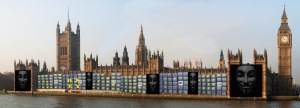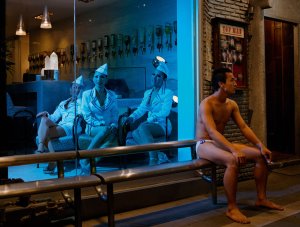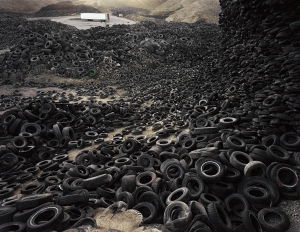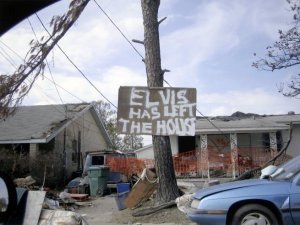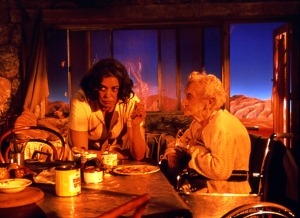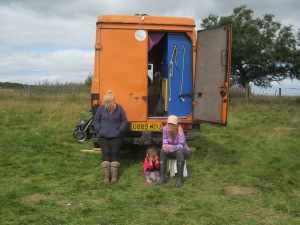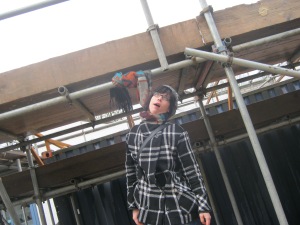“Power in the West is what displays itself most and hides itself best.”
Michel Foucault.
Using the above quotation by Michel Foucault I have interpreted it in the form of a political montage. The process I used was to take an image of the British Houses of Parliament and cover the side of the building with banks of television screens interspersed with images of the Guy Fawkes mask that are being used by the Anonymous Organisation. The television screens were then covered in various slogans that I believe represent the way Governments and other ‘ruling’ Organisations in the West use this medium to maintain their power over their citizens: ‘TV The Drug of the Nation’, ‘Watch & Obey It is the Truth’, ‘Consume – Credit is King’ and ‘Work, Eat, Live, Die’, are all examples of the way television is used to anaesthetise the general populous. There is also a bank of screens that are a reaction to this hidden agenda that is so skilfully used: ‘Reject’, ‘Rebel’ and ‘Subvert’ are all things I believe we should be doing to counteract the lies we are being fed on a daily basis. There is also one bank of screens that just says: ‘Obey’ in big letters, however, there is a prefix in smaller letters above which reads: ‘Dis-‘…. I think that the above image certainly interprets Foucault’s quotation in a creative way and shows the representation of power – Houses of Parliament – that hides itself best – within the medium of television…
NARRATIVE:
Narrative photography, sometimes called documentary photography, involves carefully selecting images and scenes to create a story. Rather than focusing on one key moment of an event, narrative photography captures images and moments throughout an event, allowing the story to unfold. Narrative photography relies on the photographer’s ability to remove himself from an event allowing it to unfold without interference. This challenges the photographer, and any people being photographed, to resist interaction with each other. The photographer must be as unobtrusive as possible, and any individuals being pictured must carry out their business naturally. In order for photography to be considered “narrative,” the event must include the interactions and influences of participants. Merely photographing objects will not create a narrative. The presence of agents within the narrative is crucial, as the players make the story. While not a character in the event, the photographer may become a character in its presentation as he decides what to portray. Context plays an important role in creating a photographic narrative. Context is created through the inclusion or exclusion of elements in the event being photographed. The context is inherently connected to the choices made when photographing the event. Narrative photography relies on a sequence of events to craft a story. Sequence may be found in the simple linear model, or may exist through flashbacks or montages of events. However organized, it is important to create a structure in order to allow the intended narrative to emerge from the photographs. Typically, the sequence will also include other elements from standard narrative, such as exposition, climax and resolution. These elements direct the narrative, introduce conflict and further develop the characters found in the story.
Courtesy of: http://www.ehow.com/info_12108302_defining-elements-narrative-photography.html
What follows are images that connected with me as I explored the work of various photographers associated with the narrative genre:
Philip Lorca DiCorcia : Top Man
Courtesy of: http://column.no/2013/11/philip-lorca-dicorcia/ [Accessed 09 April 2015]
DiCorsia has become renowned for his staged compositions, even though the viewer may be aware that the pictures are staged, it still doesn’t stop you from wondering what the story is he’s trying to portray. His work could definitely be described as narrative, mixed with the fictional world of cinema and advertising, which creates a powerful link between reality, fantasy and desire.
Edward Burtynsky: Oxford Tyre Pile, Westley, California, 1999
Courtesy of: http://www.amateurphotographer.co.uk/technique/edward-burtynsky [Accessed 09 April 2015]
“[we] come from nature.…There is an importance to [having] a certain reverence for what nature is because we are connected to it… If we destroy nature, we destroy ourselves.” – EB
Edward Burtynsky has shown the folly of mankind through his often provocative images. We are left with no alternative but to confront the damage being done to our planet through negligence, greed, and some would say progress, that is almost beyond the point of no return. The narrative within his photography should need no explanation.
Richard Misrach – Untitled (Post Hurricane Katrina).
Courtesy of: http://artblart.com/tag/richard-misrach-after-katrina/ [Accessed 09 April 2015]
Described as one of the best photographers of his generation, Richard Misrach has without doubt produced some of the most iconic narrative images associated with the environment and its destruction. His photographs of the devastation wreaked by Hurricane Katrina provide a narrative that leaves little to the imagination.
Tracey Moffatt – Night Cries: A Rural Tragedy (Film Still)
Courtesy of: http://downunderberlin.de/films/indigenous-australia/ [Accessed 09 April 2015]
This is a still taken from a Tracey Moffatt film about an adopted Aboriginal woman caring for her dying white mother. Shot in an artificially created, vibrantly coloured landscape, the narrative can be seen written all over the face of the daughter as she recounts memories and dreams that have passed her by.
Paul Riddell – That’s That Then…
Paul Riddell – Hanging Around
The last two images were taken by myself and I feel there is a certain hidden narrative in both of these photographs. The first was taken at the end of a long summer of festivals and excesses, whilst the second was taken on the Bower Ashton Campus…
